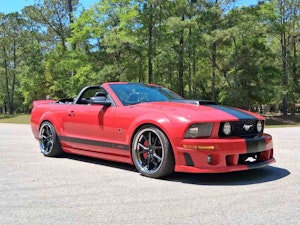Media | Articles
Lotus teases upcoming EV hypercar, codenamed Type 130
Remember the old gag about what Lotus stood for: “Lots Of Trouble, Usually Serious”? While there was more than a grain of truth behind that reliability assessment for the English sportscar maker’s early products, in recent years it became a more accurate summary of the brand’s tendency to lurch between increasingly severe crises.
In 2018 Lotus gained a new owner, Chinese automaker Geely, which took a majority stake at the same time it took control of then-parent Proton, and the prospect of actual investment. Now, at the Shanghai Auto Show, we have discovered what the company’s first all-new product since 2008 will be: an electric hypercar.
The forthcoming model, currently known by its internal code of Type 130, wasn’t at the show, however. Lotus only released a single “teaser” image to hint at what to expect when it makes its formal debut later in the year, but Hagerty has already been to the company’s Hethel HQ to see both a full-sized clay model of the car and to talk to some of the company’s senior management about it and wider plans for the future.
The Type 130 is intended to be a halo glory-spreader rather than a volume seller. It will be going into limited production next year, but Lotus isn’t planning to produce more than a very modest number—perhaps fewer than 20—with the rarity ensured by what we’re told will be a seven-figure pricetag in British pounds. (At current exchange rates £1m is $1.3m.)
Marketplace
Buy and sell classics with confidence
20190416124627)
20190416124638)
20190416124654)
Still, it is a new product from a company that has spent most of the last two decades fractionally updating existing ones.
Type 130 will be wide and low. Lotus design boss Russell Carr says that it is close in overall length to the existing Evora (the only new Lotus currently street-legal in the ‘States) meaning around 175 inches overall. It will be lower and squatter, Carr saying it will be just under two metres (79 inches) across. The structure will be made from carbon fiber with a tight-fitting two-seat passenger cabin whose narrow dimensions will allow much airflow to be directed into huge ducts under the front fenders.
At the rear it gets more interesting, with a detail the official image doesn’t even hint at. The full-sized model showed off a spectacular pair of what are being called Venturi tunnels which carry air over the rear bodywork and into sizeable vents which have the elements of the rear taillights around them. It is designed for high-speed work with what Carr confirms is a shape that owes much to both computer analysis and wind tunnel verification and will also feature moveable wings and drag-reducing Formula 1 style DRS flaps. Plus, there is a huge underfloor diffuser capable of generating significant downforce.
We will have to wait for details on the powertrain. The battery pack is located behind the passenger compartment in the space that would more normally be occupied by a hard-working V-8, V-10 or V-12 in a more traditional hypercar. Both the top of this and the mechanism for the pushrod-operated rear suspension will be visible beneath a see-through cover.
Carr confirms the car will have all-wheel drive but power output remains unknown. Lotus Cars CEO Phil Popham says that the level of performance will be “entirely appropriate” for both the part of the market the car will compete in and the rivals it needs to be considered against. We will be surprised if the total system horsepower doesn’t get into four figures.
20190416124544)
The cabin will have mostly carbon surfaces and a digital instrument pack, but more traditional button controls in place of the increasingly fashionable central touchscreen. “You want to be able to find things without taking your eyes off the road in a car like this,” Carr says. He also promises more shoulder space than in cars like the current Ford GT40 or McLaren Senna: “we don’t want people to think it will be a stripped-out track-day monster, it will be much more practical than that.”
Other high-tech details will include a digital rear-view system that uses cameras in pop-out pods integrated into the scissor-opening doors.
Beyond the 130, Lotus is committed to a range of more affordable cars. The word from Hethel is that we will see the first new-generation sports car next year, which we expect to be a replacement for the long-lived Evora based on a heavy development of the same architecture. Other models to follow will use an all-new architecture and are likely to include SUVs. Lotus’ Chinese parentage could also allow access to Volvo’s technology and powertrains, but Popham insists these won’t just be Lotus-styled versions of existing models.
“We’ve got to make sure that whatever platform we use can definitely deliver the DNA of Lotus—performance, dynamics and light weight,” he says. “What we won’t do is just take an existing platform and try to make a Lotus out of it. That wouldn’t work.”









20190416124645)
20190416124617)
20190416124608)
20190416124555)

